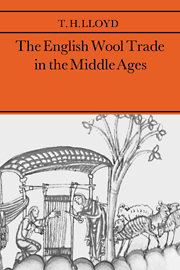Book contents
- Frontmatter
- Contents
- List of Tables and Maps
- Preface
- Abbreviations used in Notes and Bibliography
- 1 The growth of the Flemish connection
- 2 The end of the Flemish ascendancy
- 3 The Italian hegemony
- 4 The English triumphant
- 5 Edward III – woolmonger extraordinary
- 6 Quest for a staple policy
- 7 The evolution of the Calais staple
- 8 The decline of the wool trade
- 9 Marketing the wool
- Notes
- Bibliography
- Index
- Frontmatter
- Contents
- List of Tables and Maps
- Preface
- Abbreviations used in Notes and Bibliography
- 1 The growth of the Flemish connection
- 2 The end of the Flemish ascendancy
- 3 The Italian hegemony
- 4 The English triumphant
- 5 Edward III – woolmonger extraordinary
- 6 Quest for a staple policy
- 7 The evolution of the Calais staple
- 8 The decline of the wool trade
- 9 Marketing the wool
- Notes
- Bibliography
- Index
Summary
The familiar picture of the techniques used in the medieval wool trade is drawn to a very large extent from the Cely letters and papers and from other documents belonging to the legal side of the king's Chancery, few of which are earlier than the middle of the fifteenth century. By this date the export trade was but a shadow of its former self and many of its current practices had evolved only since the compulsory staple had finally been located at Calais. Unfortunately it is easier to warn against anachronistic use of late-fifteenth-century evidence than to draw an equally clear picture for the thirteenth and early fourteenth centuries, when the export trade was at its peak. The customs particulars, of which use has already been made, provide little more information than the amount of wool dispatched in the name of each merchant. The supplementary evidence, however, is scattered and when accumulated poses almost as many questions as it answers.
For only one branch of the early medieval trade is there tolerably good evidence about the way in which wool was marketed – that associated with the great monastic producers, particularly the Cistercians. The value of this evidence must not be underrated, for this was the very wool which was most in demand in the export market.
- Type
- Chapter
- Information
- The English Wool Trade in the Middle Ages , pp. 288 - 317Publisher: Cambridge University PressPrint publication year: 1977



